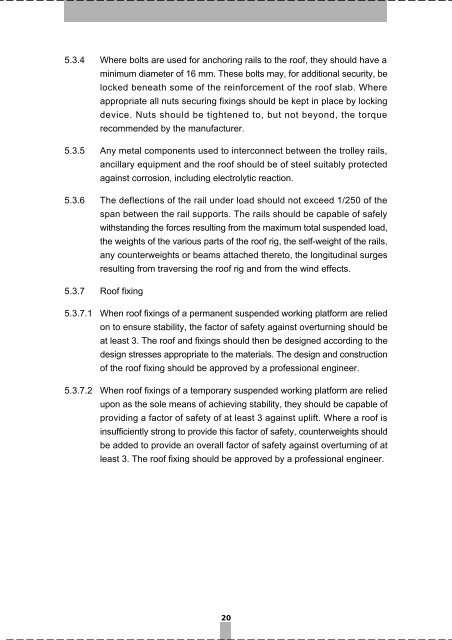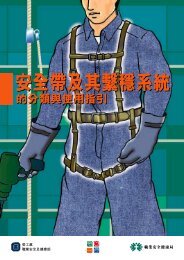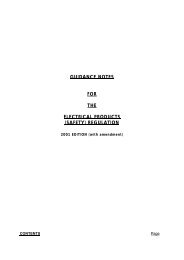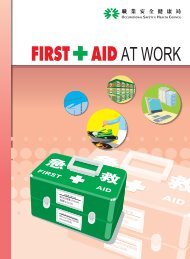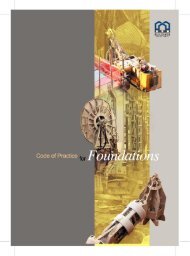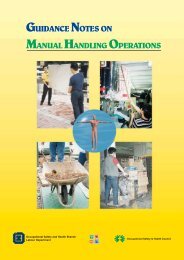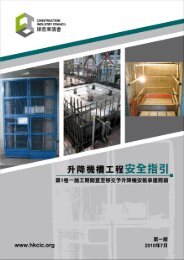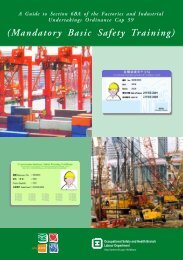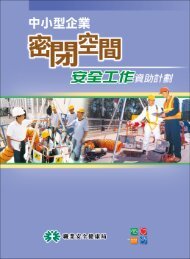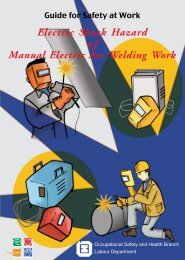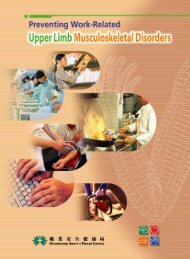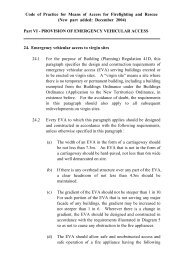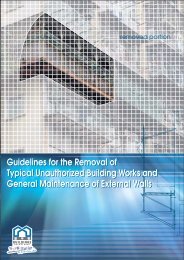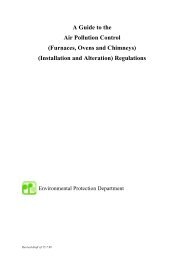Code of Practice for Safe Use and Operation of Suspended Working ...
Code of Practice for Safe Use and Operation of Suspended Working ...
Code of Practice for Safe Use and Operation of Suspended Working ...
- No tags were found...
Create successful ePaper yourself
Turn your PDF publications into a flip-book with our unique Google optimized e-Paper software.
5.3.4 Where bolts are used <strong>for</strong> anchoring rails to the ro<strong>of</strong>, they should have aminimum diameter <strong>of</strong> 16 mm. These bolts may, <strong>for</strong> additional security, belocked beneath some <strong>of</strong> the rein<strong>for</strong>cement <strong>of</strong> the ro<strong>of</strong> slab. Whereappropriate all nuts securing fixings should be kept in place by lockingdevice. Nuts should be tightened to, but not beyond, the torquerecommended by the manufacturer.5.3.5 Any metal components used to interconnect between the trolley rails,ancillary equipment <strong>and</strong> the ro<strong>of</strong> should be <strong>of</strong> steel suitably protectedagainst corrosion, including electrolytic reaction.5.3.6 The deflections <strong>of</strong> the rail under load should not exceed 1/250 <strong>of</strong> thespan between the rail supports. The rails should be capable <strong>of</strong> safelywithst<strong>and</strong>ing the <strong>for</strong>ces resulting from the maximum total suspended load,the weights <strong>of</strong> the various parts <strong>of</strong> the ro<strong>of</strong> rig, the self-weight <strong>of</strong> the rails,any counterweights or beams attached thereto, the longitudinal surgesresulting from traversing the ro<strong>of</strong> rig <strong>and</strong> from the wind effects.5.3.7 Ro<strong>of</strong> fixing5.3.7.1 When ro<strong>of</strong> fixings <strong>of</strong> a permanent suspended working plat<strong>for</strong>m are reliedon to ensure stability, the factor <strong>of</strong> safety against overturning should beat least 3. The ro<strong>of</strong> <strong>and</strong> fixings should then be designed according to thedesign stresses appropriate to the materials. The design <strong>and</strong> construction<strong>of</strong> the ro<strong>of</strong> fixing should be approved by a pr<strong>of</strong>essional engineer.5.3.7.2 When ro<strong>of</strong> fixings <strong>of</strong> a temporary suspended working plat<strong>for</strong>m are reliedupon as the sole means <strong>of</strong> achieving stability, they should be capable <strong>of</strong>providing a factor <strong>of</strong> safety <strong>of</strong> at least 3 against uplift. Where a ro<strong>of</strong> isinsufficiently strong to provide this factor <strong>of</strong> safety, counterweights shouldbe added to provide an overall factor <strong>of</strong> safety against overturning <strong>of</strong> atleast 3. The ro<strong>of</strong> fixing should be approved by a pr<strong>of</strong>essional engineer.20


